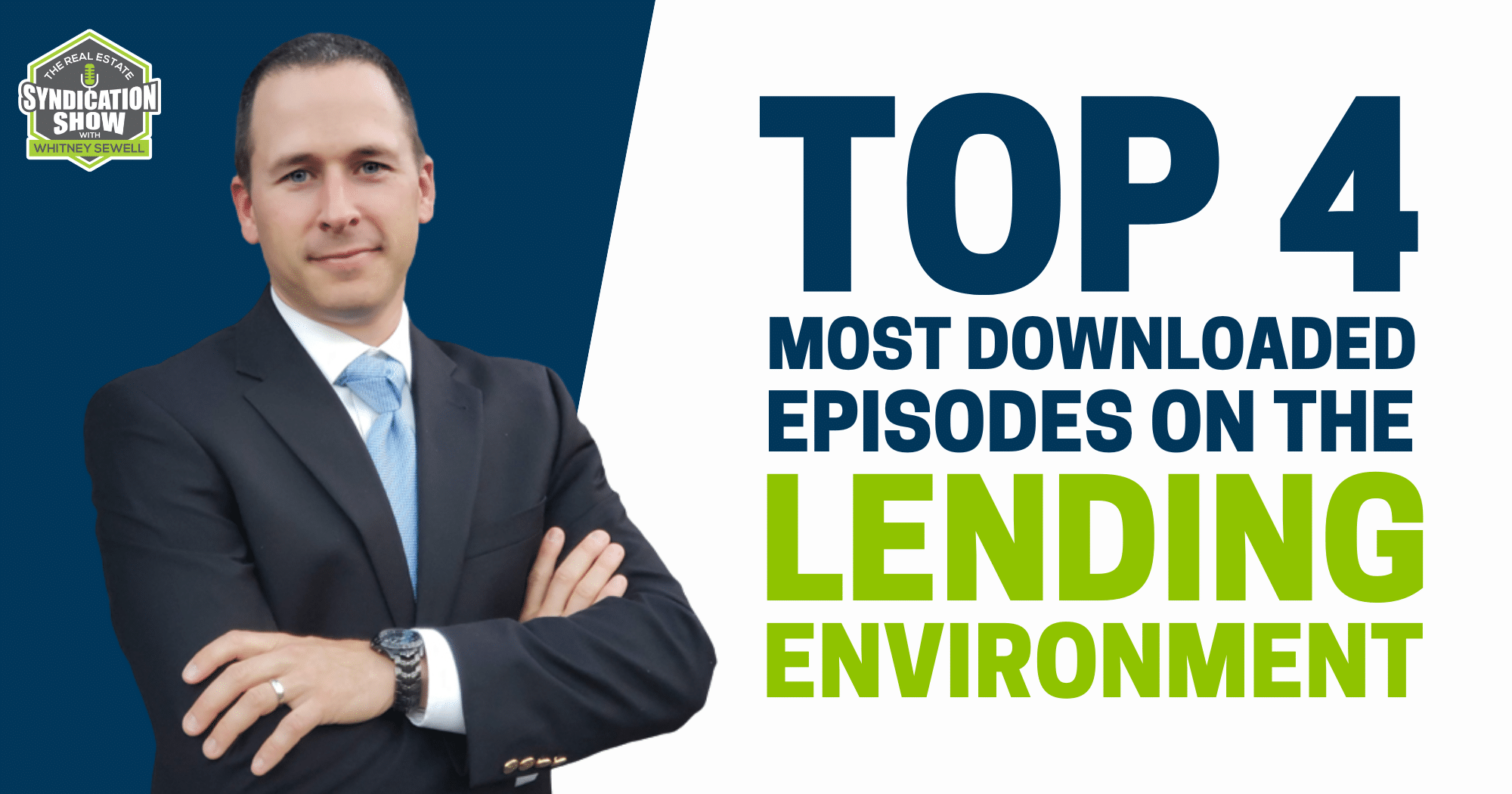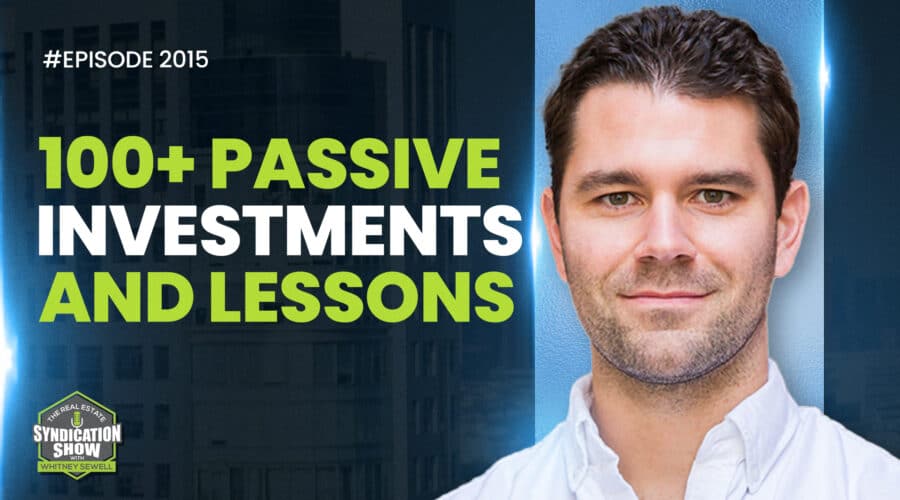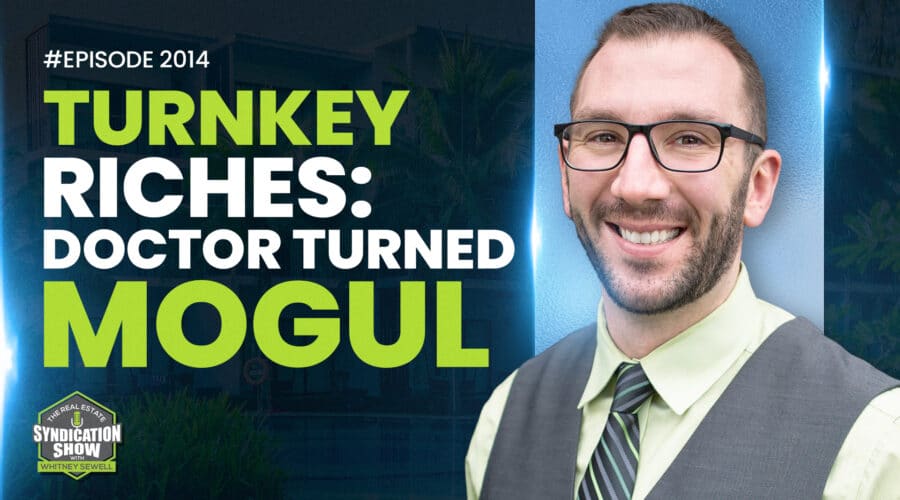For today’s episode, Kevin Dureiko, James Eng, Eric Johnson, and Freddy Johnson take us on a journey through mastering the lending environment. Kevin elaborates on how their marketing changed as Covid started unfolding. James gives us tips on what to consider when doing an underwriting for lenders and approaching them.
Our Gracious Sponsor:
Lionshare
Lionshare Bookkeeping believes the key to generating wealth is understanding where it comes from, and where it needs to go. They provide bookkeeping and financial coaching exclusively to Real Estate Investors – focusing on cash flow, strategy, and action. Go to http://bit.ly/LionshareBookkeeping to connect with them now.
Watch the episode here:
Listen to the podcast here:
As we sit with Eric, he tells us the creative ways to maximize growth through lending and the most crucial challenges of the process. And lastly, Freddy explains to us what a yield curve is and how exactly changes in interest rates affect cap rates. Don’t miss out on these best episodes and takeaways about the lending environment! Tune in now!
Key Points From This Episode:
- Where do things sit in the lending industry in the middle of COVID?
- How did the pandemic help Kevin realize who they were competing against, which changed their marketing strategy?
- James shares what interest rates he thinks investors can expect in five years.
- Insights into what you should consider when underwriting and approaching lenders.
- The creative ways people have had for lending that explodes their growth.
- The hardest part of the lending process and working with commercial investors
- Freddy talks about how interest rates affect cap rates.
- What is a yield curve?
Tweet This!
“Our job is to give people homes. In the syndication space, my job is to lend money for syndicators like you to provide good homes for people at a rate that they can afford.” – Kevin Dureiko
“When you have a private lender, you really figure out whether or not they’re private, whether or not their funds are backed by bonds or big banks, and that really opened up my eyes, especially now as to who can really fund the deals, and it kinda changed my marketing a little bit.” – Kevin Dureiko
“What always happens on the lending side is once one person, or one lender has a great product, everybody copies it.” – James Eng
“For any syndicator listening, don’t lag behind on investor docs or anything else because it just makes the deal much more stressful than it needs to be because now everyone’s anxious about the timelines and the contract and losing EMD and all this.” – Eric Johnson
“When you have a low interest environment, obviously it’s gonna make debt cheaper and thus, it’s gonna make properties more competitive, basically, so that’s gonna affect your cap rates naturally.” – Freddy Johnson
Links Mentioned in Today’s Episode:
About Kevin Dureiko
Kevin Dureiko is the founder and fund manager of Birch and Dobson LLC, a private real estate debt fund located in Connecticut. Birch and Dobson was founded in 2007. Kevin’s objectives as the Fund Manager are to source property secured investments that produce returns as expected by his capital investors. The fund and Kevin raise capital from accredited investors to place or purchase senior mortgages on investment real estate. The main focus of the fund is lending to real estate investors with mortgages in the first position on value-add syndicated multi-family properties, non-syndicated multi-family, and 1-4 family. In addition to fund manager, Kevin is also retained by a $20B hedge fund as a monthly consultant to the private lending industry.
About James Eng
James Eng serves as a Senior Director for Old Capital. James is actively involved in financing commercial real estate with a focus on multifamily in Texas. He has financed over $500 million in multifamily properties. Before joining Old Capital, James underwrote over $750 million in loans over 8 years for the acquisition or refinance of commercial properties at GE Real Estate.
Prior to his work at GE Real Estate, he completed GE’s Financial Management Program (FMP) at GE Capital with rotations in Connecticut, Colorado, and Texas across multiple businesses. He received his undergraduate finance degree from the McCombs School of Business at The University of Texas at Austin. He is currently invested as a limited partner in 21 multifamily properties totaling over 6,000 units.
About Eric Johnson
Eric Johnson began his journey with Shoreside Realty Finance two years ago. He joined them to help redefine the way real estate investors experience financing. Eric helps craft custom debt strategies for clients to maximize ROI on any type of real estate project. Eric shares the Shoreside mission to help investors achieve efficient and effective growth by delivering reliable financing solutions that are tailored to their investment strategy. Outside of Shoreside Realty Finance, Eric has had experience in fix and flips in Los Angeles and is also an active investor in the Chicago market. Eric’s passion for real estate also saw him perform as a successful real estate agent between 2017 and 2019 for Keller Williams Realty.
About Freddy Johnson
Freddy has had an interesting path through the real estate sector. Out of college, he worked for a very successful investor in Chicago who always went against the grain. It was an eye-opener for him to work for someone who had so much success in assets like MHPs, multifamily, and tax liens. He would assist in multifamily construction projects, model out potential investments, and even go to tax auctions. From there he went back to school at George Washington where he interned with Brookfield properties. He interned for a guy named Paul Schulman who was something of a role model and he went on to become COO of U.S. Operations for the company.
After grad school (May 2009) and intra recession, Freddy moved back to Chicago as there wasn’t much hiring going on in the real estate world. He met a very well-known person in the trading world (Matt Hulsizer) and he and his wife (equally impressive) started an equity options trading firm (they had a prop shop and hedge fund) called PEAK6. The firm needed an analyst to cover banks, and property and mortgage REITs…Interest rate-driven stocks. These were historically not sexy stocks to cover at the time but it became somewhat interesting as the “Fed” would cause a taper tantrum and we started to see volatility pick up in some of them during his tenure there with the “fed dots.”
Freddy also began to cover special situations (M&A, LBOs, spin-offs) and that would entail covering a lot of consumer and retail as a decent amount LBOs were happening in the early 2010s. After 5 years and being a little burnt out on the desk, he (maybe against his better judgment) decided to do a 180 and start his own company in fitness. He always had plans to return to real estate (either as an analyst or on the investment side) but he did not anticipate going to the debt side. He was introduced to StackSource by an old high school acquaintance who told me about the company and the deals he was working on. It honestly sounded colorful and fun and he admired the startup world. The guys who started it spent time working at Facebook and Google so Jon figured they were intelligent…and they are. They gave him a case study which he completed in the hospital a couple of hours before the birth of his second daughter, and a week later he was hired.
Since then, he has been able to work on financing redevs, ground-ups, refis, and acquisitions in all areas of the U.S. from Alaska to Florida. He is currently closing an SFR portfolio in Wyoming, a mixed-use portfolio in Alaska, several multifamilies across the country, and a couple of MHPs in MI and OH. He loves being in tune with the macro side of things and how it affects his clients. He also likes working with clients that want to keep learning and let me help them find the best returns for their investments. He works with them on their priorities, and he’s always candid with them as he really doesn’t have time to provide false hopes. He also knows most of his clients don’t have time as a large percentage of them work in the tech sector for companies like Google, Netflix, Facebook, and are investing in the CRE space.
Full Transcript
Episode 1634
[INTRODUCTION]
Whitney Sewell (WS): This is your Daily Real Estate Syndication Show. I’m your host, Whitney Sewell. Today, I hope you enjoy some of our most downloaded episodes on the current lending environment.
[INTERVIEW 1]
Sam Rust (SR): I’m also curious just how the industry has changed over the last couple of years. Back in 2018, I remember being in a lot of different real estate meet-ups and people wondering what inning we were in, as far as the market cycle, and everybody was waiting for the hammer to drop or the bottom to fall out, whatever your favorite term is, and then Covid hits and we all run for the hills for a little bit and the huge unknown that ends up not being maybe as bad a headwind as we had anticipated for the industry.
I’m curious from your side, on the lending side, how did that process unfold during Covid, what are some of the maybe what-ifs that we missed that are positive and or negative, and where do things sit today, in your opinion?
Kevin Dureiko (KD): When Covid first hit, nobody honestly knew what was gonna happen, so the lenders that were basically backed by Wall Street and big bank money, the money just disappeared. I would have frantic phone calls, ‘Hey, can you save this deal by next Tuesday?’ Being the Thursday beforehand, it’s like 14 days to underwrite, and you’re trying to get me to close in four. It’s just not gonna happen. I watched a lot of earnest deposit money, I watched a lot of just general money just disappear in like the first six months of what happened during Covid, and then we really got to see who is controlling the money.
KD: When you have a private lender, you really figure out whether or not, they’re private, whether or not their funds are backed by bonds or big banks, and that really opened up my eyes, especially now as to who can really fund the deals, and it kinda changed my marketing a little bit. To be able to target syndicators in this particular business really gives you an idea of how much money there is out there in the private space. As bad as Covid was, it gave us in the lending industry like, okay, the real players are A, B and C. Not throwing my name into that mix, I’m still a small fish in a very large pond. But it gave me the idea of who I was really competing with.
KD: And we just watched what Zillow tried to do with buying up single-family homes, it didn’t work. And I think when we got through most of Covid, a lot of that institutional capital realized that this isn’t just the greener side of the fence, and that you need to be here, or you’re not gonna get the phone calls. So, I think in general, we might have come out better on my end on the private debt side, because the big banks got scared. Will they come back, ’cause I kinda saw how really the industry didn’t get shaken up as much as they would. They could, but I think they’re still a little shy and scared about it.
SR: In my estimation, that seems like a healthy thing, whenever you have an industry get centralized, I always worry what systemic risks are being introduced into the market, and you can see that in the great recession of 2008 with the mortgage back securities and how that introduced a variable that nobody really could see at the time, and yet in retrospect seems so obvious.
SR: Do you think that maybe we dodged a bullet by not going through a wave of consolidation on the debt side during Covid, and you didn’t have a Blackstone or a Morgan Stanley or somebody like that, get a wild hair and go accumulate hundreds of these smaller shops?
KD: Absolutely, and it doesn’t just wouldn’t have stopped on the debt portion, we were probably two or three months away from them realizing that Covid would not hit this industry as hard as they thought it was going to. And we just needed a one multi-billion-dollar hedge fund and just to start walking down Main Street and buying up apartment buildings. We would have been having a very different conversation had they come to that realization sooner and what would have happened.
KD: And it’s not just our industry, it’s like what would have happened with the renters, if Blackstone comes through and they just did this and has Blackstone or one of the large hedge funds, they walk through Pennsylvania and bought up hundreds of single-family homes at one time, and if you look at that area and you do a price comparison for rentals, they raised the prices up to 30%. That’s not what we serve, that’s not the industry that it should be.
KD: Our job is to give people homes. In the syndication space, my job is to lend money for syndicators like you to provide good homes for people at a rate that they can afford. We’re seeing it now with the single-family homes being completely run-up in prices, who’s to say that wouldn’t have happened with multifamily as well.
SR: Well, in many ways, I think multifamily just moves a little bit slower because it’s not quite as transactional, and even there in some of the local markets that we transacted, December was a record month, both for a number of transactions for total volume, dollar volume, or seeing pricing records fall, it seems like that wave is only continuing to build in the multifamily space, just like we’ve seen in the headlines for single-family.
KD: Right. And of course, everybody’s in the business to provide value and the more value you get, the more rent you should be able to charge. And of course, that’s the idea, one that we all have to work by, but to have somebody or a big entity come in and just be a number and raise those prices without providing a value to give renters a better lifestyle, life standard for that money could have been a very big concern when you have to pay for nothing just because, you have to placate the shareholders and get your stock price up. It’s a different conversation.
[INTERVIEW 2]
Whitney Sewell (WS): What always happens on the lending side is once one person, or one lender has a great product, everybody copies it. What happens is other banks are going to start copying this. Then as investors start seeing the people who buy these loans, once they see that they’re receiving a lot of demand, they’re going to start increasing the spread. Once that happens, then your interest rate might be higher than it is on a fixed rate product.
James Eng (JE): It’s all about demand and supply. I mean, I think that’s one of the advantages of coming to somebody who’s in the market day in and day out is they understand what the best loan product is in today’s market for you.
WS: Say the listener just closed on a property in the last few months, with what you know about the lending environment and just real estate environment in general, what do you expect what to happen, say five years from now when they’re looking to exit four or five years from now, what will interest rates be then, or do you expect, or do you have any idea and what should they be thinking about?
JE: I mean, nobody really tries to predict interest rates too much. I mean, the hard thing – I mean, there’s definitely forecasts for LIBOR and SOFR and 10-Year Treasury and stuff like that. Overall, flat to down is what most people are predicting. That has impacted the reversion cap rate. The question I get a lot from investors is like, “Okay. When I sell this deal in five years, what am I going to be able to sell it for?” The typical answer was 10 basis points per year. If you’re buying out of five now, you should probably use a five and a half cap in your five.
JE: Now what we’re seeing is cap rates continue to compress, because interest rates have gone down. Before, let’s say the average cap rate was 5% in DFW, now it’s probably 4.50%. Now the interest rates have gone down. If you use a 6%, 6.50% residual cap and you can still win the deal and the numbers work, then that’s off. That’s probably a good deal. In order to compete right now, you’re probably in that 5% to 5.50% range on the residual. Yeah.
WS: What else in our personal underwriting are you going to want to see that we’ve taken account for, or anything else that we haven’t mentioned that the listener should be accounting for when they’re underwriting these properties before they come to get lending?
JE: Well, a couple things. Right now, we are seeing rents be essentially flat. In that first year, unless you’re way under market, most people are not underwriting that 3% organic rent growth in year one. I would keep that flat. I probably build in a little bit more for concessions and bad debt until some of the eviction moratorium stuff goes away, hopefully. That’s what I would say on the underwriting piece.
JE: From the lending piece, what’s more important is Fannie and Freddie, they essentially have the same net worth and liquidity guidelines that they had before. Your net worth needs to be equal to, or greater than the loan amount. Your liquidity needs to be 10% of the loan amount, or higher. That’s post-close liquidity of the guarantors. We like to see everybody’s balance sheet upfront.
JE: Then right now, the bigger issue is really the equity rates. The people who when they’re going in, submitting a deal to the listing broker, the listing broker will call us and say, “Look.” Number one, can they qualify for the debt? Number two, what is your comfort level for this person raising the equity? Because it’s not just the 20%, 25% that you need to raise. It’s also that additional 9 to 12 months of PNI, which is additional 5%. Can you raise that on top of it? You’re probably going to have to raise your rehab on top of that.
JE: As long as you feel comfortable doing all those things, then that’s when I can give you the check mark and tell the listing broker, “Hey, this guy’s for real. He can qualify for the debt. He can raise the equity and he should win the property.”
WS: Is that going to be from pre-existing relationships with you, or the lender, I mean, how you’re going to know that? I know the listeners thinking right now, “Wait a minute. I’m just about to get into my first syndication. How do I establish that relationship with James, or whoever that lender is, so they can give me that check mark?”
JE: Yeah. I mean, I think a couple conversations before the deal for sure. What we usually ask for is we’ll sit down with someone, review their personal financial statement. Anybody who else is going to sign with you, so any other loan guarantors, we’re going to speak with them, go through their PFS and schedule real estate. Make sure there’s no issues. Then once we have that ironed out, then we know that you can qualify for that loan and then we make sure that the property can qualify for that loan. We check all the boxes first and make sure you’re qualified, property’s qualified and that when we take it into Fannie and Freddie, there won’t be any surprises.
WS: Are there any anything else you’d like to see for somebody to be prepared for a worse downturn?
JE: Liquidity is always probably the biggest thing. Fannie and Freddie required 10%. You can use that, let’s say you had a million dollars in liquidity and you sign on 10 deals. Well, you can use that same million dollars across all those Fannie Mae loans. In reality, that liquidity can only be used once. I would rather somebody take it a little bit slower and make sure their deals are comfortable and reviewing how the property, like if it did dip in occupancy to 80%, 85%, how many months of reserve do you have.
JE: In March, that was the calculation. In March, the calculation was okay, if it gives the 30% or 40% delinquent on our rent roll and we just pay the expenses, how long can we survive? There was a lot of syndicators who had plenty of money at the property level and on their personal balance sheet. That gives a lot of comfort to the lender and then also, probably to your investors that you have the balance sheet to weather the storm.
JE: I mean, let me give you an example of a deal that essentially was along the coast, got hit by a hurricane and actually, wasn’t in a flood plain, so they didn’t have flood insurance. The general partner actually had to front the money to get the units back online. Once he got them back online, he got the property sold. That was a big loan to the partnership. If the general partner didn’t have a sizable balance sheet to do that, then a lot of those LPs probably would have lost their money in that deal.
[INTERVIEW 3]
WS: What are a couple ways that you’ve seen people get creative with lending to just help explode their growth?
Eric Johnson (EJ): Really value-add. So, syndicators are all about value-add. So, in my experience and funding these deals, really, it’s going after bridge debt at the beginning. So, if the sponsor really identifies a good value-add asset, and there’s a lot of potential for upside, you can definitely come in with a bridge loan at 75 LTV and maybe 100% construction. It’s essentially going to be like a BRRRR deal, but for multifamily, if you want to think of it like that. So, you’re essentially fixing it, rehabbing it, stabilizing it, and refinancing. So, if you’re a syndicator listening to this, if you can really use bridge debt creatively in addition to an equity raise, and by putting those two together, you can really come into a deal very strong. And by the time that you fix up the property, and hopefully underwrite conservatively, you still have a lot of upside to capture. But once the property is stabilized, once you refi and hold it, you should be able to capitalize on even a cash out refi and disperse some of that equity back, and obviously, lower your rate and, and get better terms on it.
EJ: But again, you know, on the on the value-add side, still going to be, probably a 12 to 24-month bridge loan, depending on how big the project is. If it’s a 50-unit building, it needs a million bucks in capex, then we’ll probably shoot for 24-month initial plus some six months extensions here and there.
WS: Eric, what’s the hardest part of this lending process or working with a commercial investor or a syndicator?
EJ: Yes, I mean, really, it’s just about the documents. I got to say that the delay between me getting the documents and me submitting it is pretty much zero. I submit it like it’s within the hour. But if people are taking an hour to get, or sorry, a week to get documents back to me, that are critical and I mentioned that in the beginning, it makes the process way more difficult than it ever needs to be. Because, as I look at it, if something goes wrong, and we wasted a week in the beginning, we don’t have that week on the back end, when something actually does go wrong.
EJ: So, I want to make that very, very clear, especially with large transactions like this, because when you get the appraisal back, that’s when the box kind of opens up, so to say, of potential issues to deal with. So, for any syndicator listening, don’t lag behind on investor docs or anything else because it just makes the deal much more stressful than it needs to be because now everyone’s anxious about the timelines and the contract and losing EMD and all this.
WS: Nice. I appreciate you elaborating on that or just hammering that home a little bit. No doubt about it. You want to be as prompt as possible through the entire process because you need that extra week sometimes.
EJ: Absolutely.
WS: So, how do like to see operators preparing for a downturn when they’re presenting themselves for a loan or for a debt?
EJ: Yes. So, as far as a deal package, so to say, or a pitch for either potential investors or for debt, you want to really make sure you showcase the asset and business plan is. So, you have the entrance, the execution and the exit. Those are the three stages. If you can’t give me every detail about those, then there’s probably something, a gap in your model or something that’s missing. As far as just screening debt, it’s pretty easy. Getting and offering memorandum, two years income statements, current rent roll, and then if it’s a value-add deal, please explain what that value-add is, what the NOI is going to be, and then what the stabilized value is going to be if an area cap rates, or what you estimate to be your cap rate and your exit, whether it be in three or five years or what.
EJ: But if you have those basic documents, it’s pretty easy to come in and say, “Hey, is this deal you guys are interested in and this is a value-add, 50-unit in blah, blah, blah, here are the docs.” And at that point, it’s pretty easy to screen.
[INTERVIEW 4]
Freddy Johnson (FJ): When you have a low-interest environment, obviously it’s gonna make debt cheaper and thus, it’s gonna make properties more competitive, basically, so that’s gonna affect your cap rates naturally, as far as how that is gonna…
FJ: The tools that the PMC uses, you obviously have your overnight lending rate, the rate the banks lend to each other, that is kind of a target set by the FOMC, you also have QE, which we’ve seen 10 plus years ago and are seeing again now and now, Duran Powys basically said, hey, we’re gonna have this for another two years, so people now are seeing… And now we have this yield curve that have steeped in, and I think on Friday it kind probably hit…
FJ: I think it was like 30-year hit, like 2.4 percent. And so, all we’re hearing about now is inflation, that’s all you see in the media, what is inflation and how does that affect the real estate investor? And so it’s kind of like you’ve seen a lot of people pull out of these lower interest earning securities, they’ve gotta make more in their dollar. The same is true for the lenders, their dollar today is gonna be worth less tomorrow, and thus they have to possibly raise rates.
FJ: However, we have the other side of that, where you have Powell saying, no, we’re gonna be buying a 120 billion a month in securities, and that is going to keep rate slow and we’re gonna do that for the next two years in elective inflation spikes, and we hit 2.5% or even maybe 3%, I’m not sure exactly what he said in terms of the percentage, then that’s fine, and inflation is good generally for the economy.
FJ: The fact of the matter is, though, is that we’re not gonna see inflation like we did in 1970s, we’re not gonna see that massive interest rate spike that we saw in the early 80s on… 1988, 82, it’s just not gonna happen. We’re living in a different world right now, we have globalization, that is completely… Any money that we get from the stimulus, this 1.9 billion times, a lot of it’s gonna go back to China, it’s gonna be pushing goods back to us, and we have digitization these days that is gonna keep prices relatively low…
FJ: The competition out there in the market to… And this race or that we see on marketplaces like Amazon is kind of taken over, and so I just don’t see those massive interest rates spike, and especially with the Fed buying all these securities over the next 24 months, I don’t really see it. And so I think that a lot of news outlets have kind of dialed back all their top of inflation in the past week or two, but up until then, all you heard with people talking about inflation, inflation inflation. How is it gonna affect us? How is it gonna affect our debt? And are we really gonna be scrambling to find quality, good interest rates, so… Yeah.
WS: Yeah. No, that’s some great information. And food for thought. No doubt about it. And I know you mentioned yield curve and inflation and I was like, take 30 seconds, so what is the yield curve? Somebody hasn’t heard of that before, why is that important to us in real estate?
FJ: Yeah. So the yield curve, you can just look at it as all of the… I don’t even know what the yield term is the Treasury interest rates, so going from anywhere from a short-term to long-term, and obviously on your short duration securities, you’re gonna have less risk and thus less interest that you’re gonna earn on those… The longer duration ones, your 30 years, you’re gonna be the more in a low interest rate environment right now, so 2-2.5%.
FJ: And when you have a steep yield curve is generally a sign of good economic conditions to come when you have an inverted yield curve, and you start to have people kind of dumping their shorter term securities, that is not generally a good sign. So when we saw that at the very beginning of covid, we saw that yield curve kind of turn… Or inverted, turn upside down a little bit. And it was no surprise in what was coming, so… Yeah…
WS: Well, on that same thought, but even more in depth, I’d love your opinion about just what you see for the next six to 12 months, just in the real estate market, and then maybe also in the lending as well.
FJ: Yeah, so in the real estate market in the next six, 12 months, I think that we’re gonna see… And we kind of saw this over the past couple of years anyway, but you have more institutional investors that are going to be hunting for cash on cash, so the guys out there, the scrappy, you know, 30-year-olds that are trying to invest in, you know, a mobile home park with a couple of partners, the guys that are doing the single family rental portfolios outside of Kansas City that maybe work at Google, but they make a lot in tech and they wanna diversify and they’re really interested in real estate.
FJ: Those institutional investors, they’re gone in for those assets now, they’re not just all about the office properties in the 250-unit multi-families, there’s been a lot of capital that has been flowing into these different assets, and so the competition for those is gonna increase, and that’s what I see in the real estate world is just… It’s not like an asset has to be sexy to invest in it, it’s just… it’s gonna be all about the returns from here on out, and people are seeking Alpha anywhere, so…
FJ: Yeah, that’s what I see in the real estate market as far as the lending market goes, I think that while we have a steepening yield curve, I don’t think the interest rates are gonna get through out of hand, I think that has indicated that… Maybe I’ll learn different in the next 48 hours with this FOMC meeting going on, but I really just see interest rates staying relatively low, which can be a double edged sword for the investor, it’s great in terms of debt financing, but then again, it can make… Finding good quality assets hard to find.
[END OF INTERVIEW]
[OUTRO]
WS: Thank you for being with us again today. I hope that you have learned a lot from the show. Don’t forget to like and subscribe. I hope you’re telling your friends about the Real Estate Syndication Show and how they can also build wealth in real estate. You can also go to LifeBridgeCapital.com and start investing today.
[END]
Love the show? Subscribe, rate, review, and share!
Join the Real Estate Syndication Show Community:








